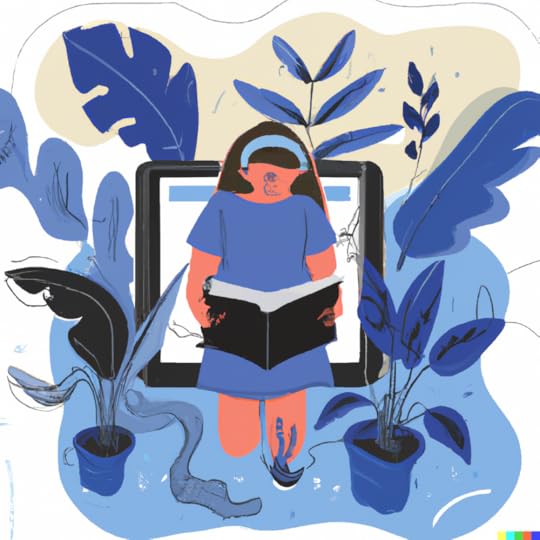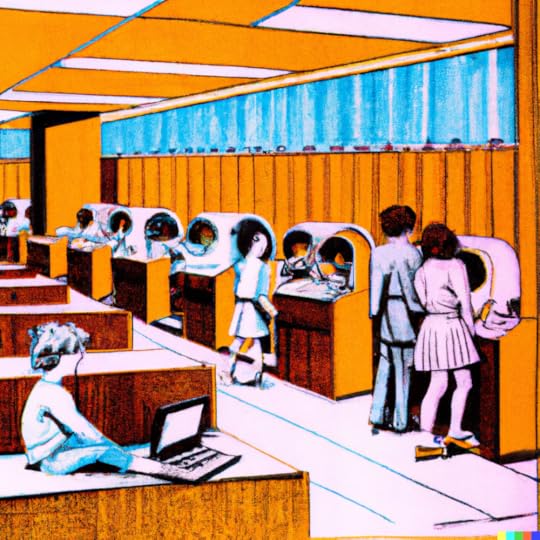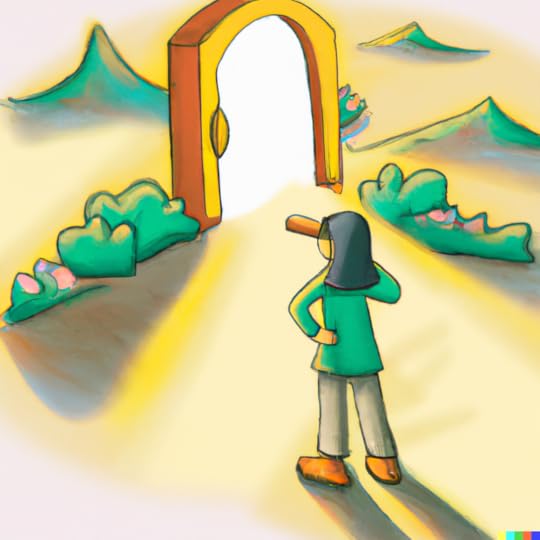Matthew Murrie's Blog, page 5
January 7, 2023
What to Wonder for English Language Learning

Eight Curiosity Questions and Actions to kick off any English learning experience to enhance learning with wonder using Curiosity-Based Thinking
1. What if all the words in the English language were only three letters long?Action 1:
Create your own three-letter words and see if your classmates can guess what they mean.
Action 2:
Write simple sentences or even a short story using only three-letter words.
2. What if animals could talk in English?Action 1:
Brainstorm what different animals might say if they could talk.
For example, a cow might say "Moo, I'd like a salad please" at a restaurant.
Action 2:
Try acting out conversations between animals in English.
3. "What if all objects in the world had to be described using only adjectives that start with the letter 'b'?"Action 1:
Brainstorm a list of objects and then come up with descriptive words that start with "b" to describe them.
For example, a tree might be "big", "brown", and "bendy".
4. "What if everyone in the world had to speak English with a different accent every day?"Action 1:
Try speaking with different accents and see if classmates can guess where the accent is from.
Action 2:
Try playing a game where you have to imitate different accents.
5. "What if the English alphabet had 50 letters instead of 26?"Action 1:
Brainstorm what some of the extra letters might be and how they might be pronounced.
Action 2:
Try writing simple words or sentences using the extra letters.
6. What if there were no silent letters in English?"Action 1:
Try saying words with silent letters out loud and see if anyone can guess what the word is.
Action 2:
Play a game where everyone has to say words with silent letters as quickly as possible.
7. "What if nouns could only be described using verbs?"Action 1:
Brainstorm a list of nouns and then come up with verbs to describe them.
For example, a table might be "supporting", "holding", or "holding up".
8. "What if everyone had to speak English backward?"Action 1:
Try saying simple phrases backward and see if others can guess what they are.
Action 2:
Play a game where everyone must say words backward as quickly as possible.
Curious why more curiosity is great for whatever you are doing?
Curiosity is a bio-hack. ,As Dr. Huberman points out, the act of getting curious releases dopamine, serotonin, and norepinephrine simultaneously to produce a unique effect on the human body and brain. Learning how to harness and leverage this “hack” gives you a tremendous advantage in getting more done in whatever you are doing and finding greater satisfaction in what comes from it.
Curiosity can be so many things, it is easy to get lost in its power and potential. To simplify things here's a quick list of just some of what we know curiosity can do. Enjoy and stay curious!
Curious people are ,less anxious Curious people are ,less timid Curious people are ,not as defensive during initial counters with strangers Curious people have ,less aggressive actions to perceived triggers Curious people have ,improved conflict resolution skills Curious people have ,enhanced motivation to put themselves in another's shoes Curious people have ,less attachment to their own ideas Curious people have ,an increased interest in others' ideas Curious people are ,more likely to receive social support at work Curious people are ,more effective at building connections at work Curious people are ,more effective at building trust at work Curious people are ,more committed to their teams at work Curious people ,discover more innovative solutions that increase one's sense of meaningfulness at workBe sure to follow along with What If Curiosity as I will dive deeper with more specific examples and actions for how you can take a Curiosity-Based Thinking approach to learn, get, and enjoy more out of all you do.
Stay curious!
Matt
Let's chat to maximize the power of your curiosity!
What to Wonder for English Language Learning

Eight Curiosity Questions and Actions to kick off any English learning experience to enhance learning with wonder using Curiosity-Based Thinking
1. What if all the words in the English language were only three letters long?Action 1:
Create your own three-letter words and see if your classmates can guess what they mean.
Action 2:
Write simple sentences or even a short story using only three-letter words.
2. What if animals could talk in English?Action 1:
Brainstorm what different animals might say if they could talk.
For example, a cow might say "Moo, I'd like a salad please" at a restaurant.
Action 2:
Try acting out conversations between animals in English.
3. What if all objects in the world had to be described using only adjectives that start with the letter "b"?Action 1:
Brainstorm a list of objects and then come up with descriptive words that start with "b" to describe them.
For example, a tree might be "big", "brown", and "bendy".
4. What if everyone in the world had to speak English with a different accent every day?Action 1:
Try speaking with different accents and see if classmates can guess where the accent is from.
Action 2:
Try playing a game where you have to imitate different accents.
5. What if the English alphabet had 50 letters instead of 26?Action 1:
Brainstorm what some of the extra letters might be and how they might be pronounced.
Action 2:
Try writing simple words or sentences using the extra letters.
6. What if there were no silent letters in English?Action 1:
Try saying words with silent letters out loud and see if anyone can guess what the word is.
Action 2:
Play a game where everyone has to say words with silent letters as quickly as possible.
7. What if nouns could only be described using verbs?Action 1:
Brainstorm a list of nouns and then come up with verbs to describe them.
For example, a table might be "supporting", "holding", or "holding up".
8. What if everyone had to speak English backward?Action 1:
Try saying simple phrases backward and see if others can guess what they are.
Action 2:
Play a game where everyone must say words backward as quickly as possible.
Curious why more curiosity is great for whatever you are doing?
Curiosity is a bio-hack. ,As Dr. Huberman points out, the act of getting curious releases dopamine, serotonin, and norepinephrine simultaneously to produce a unique effect on the human body and brain. Learning how to harness and leverage this “hack” gives you a tremendous advantage in getting more done in whatever you are doing and finding greater satisfaction in what comes from it.
Curiosity can be so many things, it is easy to get lost in its power and potential. To simplify things here's a quick list of just some of what we know curiosity can do. Enjoy and stay curious!
Curious people are ,less anxious Curious people are ,less timid Curious people are ,not as defensive during initial counters with strangers Curious people have ,less aggressive actions to perceived triggers Curious people have ,improved conflict resolution skills Curious people have ,enhanced motivation to put themselves in another's shoes Curious people have ,less attachment to their own ideas Curious people have ,an increased interest in others' ideas Curious people are ,more likely to receive social support at work Curious people are ,more effective at building connections at work Curious people are ,more effective at building trust at work Curious people are ,more committed to their teams at work Curious people ,discover more innovative solutions that increase one's sense of meaningfulness at workBe sure to follow along with What If Curiosity as I will dive deeper with more specific examples and actions for how you can take a Curiosity-Based Thinking approach to learn, get, and enjoy more out of all you do.
Stay curious!
Matt
Let's chat to maximize the power of your curiosity!
January 6, 2023
ChatGPT in the Classroom: A Guide for Educators

As an educator, you are always looking for ways to engage and support your students and how they learn. Chatbots like ChatGPT can be a valuable tool in this effort, providing personalized assistance and facilitating collaboration in the classroom.
But how can chatbots like ChatGPT be used effectively in the classroom?Here are some actions to take:Identify the concept that students are struggling with.
This could be a specific math skill, a grammar rule, or any other concept that students are having difficulty with. Then, create customized quizzes or exercises for the chatbot to deliver.
For example, if students are struggling with a particular math skill, the chatbot could deliver a series of problems for students to solve. The chatbot could then provide feedback and additional explanations as needed to help students better understand the concept.
Another option is to use the chatbot to provide additional explanations and examples. For example, if students are struggling with a grammar rule, the chatbot could deliver explanations and examples of the rule in action, helping students to better understand and apply it.
Determine how ChatGPT can be used to help students practice and reinforce this concept.This might involve creating customized quizzes or exercises for the chatbot to deliver, or using the chatbot to provide additional explanations and examples.
Here are a few examples of customized quizzes and exercises that a chatbot like ChatGPT could create to help students practice and reinforce a particular concept:
Multiple-choice quizzes:
The chatbot could create a series of multiple-choice questions related to the concept being studied. For example, if students are learning about fractions, the chatbot could ask questions like "Which of the following is equal to 1/2? A) 2/4 B) 3/6 C) 4/8 D) 5/10."
Fill-in-the-blank exercises:
The chatbot could create exercises where students have to fill in the blank with the correct answer. For example, if students are learning about parts of speech, the chatbot could provide a sentence with a blank and ask students to fill in the correct noun or verb.
Drag-and-drop activities:
The chatbot could create interactive drag-and-drop activities where students have to place different elements in the correct order. For example, if students are learning about the steps of the scientific method, the chatbot could ask students to arrange the steps in the correct order.
Here are a few examples of additional explanations and examples that a chatbot like ChatGPT could provide to help students better understand a particular concept:
Definitions and explanations:
The chatbot could provide definitions and explanations of key terms related to the concept being studied. For example, if students are learning about photosynthesis, the chatbot could provide definitions and explanations of terms like "chlorophyll" and "carbon dioxide."
Real-world examples:
The chatbot could provide examples of the concept being studied in action. For example, if students are learning about the water cycle, the chatbot could provide examples of how the water cycle works in different parts of the world.
Case studies:
The chatbot could provide case studies that illustrate the concept being studied in a real-world context. For example, if students are learning about the impact of pollution on the environment, the chatbot could provide case studies of different pollution incidents and their consequences.
Integrate ChatGPT into the classroom.This might involve using the chatbot during specific periods of the school day, or assigning students to work with the chatbot on a regular basis. For example, the chatbot could be used for a half-hour each day to provide additional practice and support for students who are struggling with a particular concept.
Another option is to assign students to work with the chatbot on a regular basis. This might involve setting aside a specific time each week for students to work with the chatbot, or assigning students to use the chatbot as part of their daily homework routine.
Monitor student progress and adjust the use of ChatGPT as needed.It is important to regularly assess student progress and make adjustments to the use of the chatbot as needed. This might involve adjusting the types of activities or questions that the chatbot delivers, or finding new ways to use the chatbot to support student learning.
Use ChatGPT as a supplement to, rather than a replacement for, human instruction.While ChatGPT can be a valuable resource for students, it should not be used as a replacement for human teachers. Instead, it should be viewed as an additional tool to support and enhance the educational experience.
ChatGPT can be used to supplement human instruction in a number of ways. For example, the chatbot could be used to provide additional explanations and examples or to deliver customized quizzes and exercises.
It is important to remember, however, that ChatGPT should not be used as a replacement for human teachers. While the chatbot can be a valuable resource for students, it is ultimately the role of human teachers to provide guidance and support for students as they learn.
By following these steps, you can effectively use chatbots like ChatGPT to support your students as they learn. Whether you are looking to provide additional practice and support for struggling students, or to create a more interactive and engaging learning environment, chatbots like ChatGPT can be a valuable addition to your classroom.
Be sure to follow along with What If Curiosity as I will dive deeper with more specific examples and ideas for how you can take a Curiosity-Based Thinking approach to learn and get more out of chatbots and AI tools.
Stay curious!
Matt
Curious to discover how to get more from your curiosity? Please reach out! I would be happy to discuss the ways in which embracing and nurturing curiosity through Curiosity-Based Thinking can drive innovation and success in your organization.
Contact me to set up a consultation and maximize your curiosity's power.
January 5, 2023
Chatbots in Education: Maximizing the Benefits and Minimizing the Drawbacks

Chatbots are becoming increasingly popular in education, with many schools and universities exploring the use of these artificial intelligence (AI) tools to supplement human instruction and provide additional support for students.
While many educators and institutions are ,attempting to ban chatbots. Others ,are embracing them.
,OpenAI's ,ChatGPT is a ,chatbot that has gained great popularity in educational settings for many reasons. Chatbots can provide students with an opportunity to practice their language skills and learn about artificial intelligence and natural language processing. They can also be used to supplement human teaching, providing additional support and resources for students, but what are the potential benefits and drawbacks of using chatbots like ChatGPT in the classroom?
Benefits of Using Chatbots in EducationThere are several potential benefits to using chatbots in education:
Practice language skills:Chatbots can provide students with an opportunity to practice their language skills, including reading, writing, and speaking. This can be particularly useful for language learners, or for students who may benefit from additional practice with a particular language.
Supplement human instruction:Chatbots can be used to supplement human teaching, providing additional support and resources for students. This can be particularly useful in large classrooms where it may be difficult for a single teacher to provide personalized attention to each student.
Learn about AI and NLP:Chatbots can also be used as a learning tool, helping students to understand and learn about artificial intelligence (AI) and ,natural language processing (NLP). This can be a valuable opportunity for students to learn about cutting-edge technology and its applications.
Personalized learning:Chatbots can be programmed to provide personalized learning experiences for students, tailoring the content and pace of instruction to the individual needs and abilities of each student. This can be a powerful tool for helping students to learn at their own pace and in a way that is most meaningful to them.
Accessibility:Chatbots can be accessed from anywhere with an internet connection, making them a convenient and accessible resource for students. This can be particularly useful for students who may not have easy access to a physical classroom or teacher.
Drawbacks of Using Chatbots in EducationWhile there are many potential benefits to using chatbots in education, there are also some valid concerns to consider:
Limited personalization:Chatbots may not be able to provide the same level of personalized support and feedback as human teachers. While chatbots can be programmed to provide personalized learning experiences, they may not be able to fully replicate the personalized attention that a human teacher can provide.
Limited ability to replace human instruction:Chatbots may not be able to fully replace human instruction, particularly in more complex or nuanced subjects. It is important to use chatbots to supplement, rather than replace, human instruction in the classroom.
Privacy concerns:There may be privacy concerns associated with using chatbots in the classroom, particularly if they are collecting and storing student data. It is important to address these concerns and put appropriate measures in place to protect student privacy.
Maximizing the Benefits of ChatGPT in Public SchoolsIn order to ensure that chatbots like ChatGPT are used to their greatest benefit in public schools, there are a few steps that schools can take:
Clearly define the goals and objectives of using chatbots in the classroom. This will help to ensure that chatbots are being used in a way that aligns with the overall educational goals and objectives of the school.
Use chatbots to supplement, rather than replace, human instruction. Chatbots can be a useful resource for students, but they should not be used as a replacement for human teachers.
Ensure that chatbots are used in a way that promotes student learning and engagement. This may include using chatbots to provide personalized learning experiences, or using them to facilitate discussion and collaboration among students.
Monitor and evaluate the use of chatbots in the classroom. This can help to identify any potential issues or concerns and to ensure that chatbots are being used effectively and in a way that benefits students.
Address privacy concerns. Chatbots may collect and store student data, so it is important to ensure that appropriate measures are in place to protect student privacy. This may include obtaining parental consent for the use of chatbots, as well as implementing appropriate security measures to protect student data.
Chatbots like ChatGPT have the potential to enhance education in public schools by providing students with additional resources and support, and by facilitating personalized learning experiences. However, it is important for schools to carefully consider the potential benefits and drawbacks of using chatbots in education, and to take steps to ensure that chatbots are used in a way that maximizes their benefits and minimizes any negative impacts. By following best practices and taking a thoughtful approach to the use of chatbots in the classroom, schools can ensure that chatbots are a valuable and effective tool for enhancing education.
Be sure to follow along with ,What If Curiosity as I will dive deeper with more specific examples and ideas for how you can take a Curiosity-Based Thinking approach to learn and get more out of chatbots and AI tools.
Stay curious!
Matt
Curious to discover how to get more from your curiosity? Please reach out! I would be happy to discuss the ways in which embracing and nurturing curiosity through Curiosity-Based Thinking can drive innovation and success in your organization.
Contact me to set up a consultation and maximize your curiosity's power.
January 3, 2023
Unlock Your Potential with Curiosity-Based Thinking

It's easy to get caught up in the hustle and bustle and lose sight of what truly drives us. But by cultivating your curiosity and embracing a Curiosity-Based Thinking approach, you can unlock your full potential and achieve greater success and satisfaction in both your personal and professional lives.
What is Curiosity-Based Thinking?Curiosity-Based Thinking is a way of approaching problems and decision-making that is centered around exploring and learning. It involves asking questions, seeking out new information, and being open to different perspectives in order to gain a deeper understanding of a problem or situation.
Curiosity-Based Thinking helps you improve your critical thinking skills and approach problems with a more open and flexible mindset, leading to more creative and effective solutions.
How can Curiosity-Based Thinking benefit you?Asking questions:By asking questions and seeking out answers, you gain a deeper understanding of a problem and identify potential solutions.
Gathering information:Curiosity-Based Thinking encourages you to gather information from a variety of sources, which helps you see problems from different perspectives and consider a wider range of potential solutions.
Considering different viewpoints:Being open to different viewpoints and considering different perspectives helps you think more critically about problems and make more informed and reasoned decisions.
Using Curiosity-Based Thinking to cultivate your personal curiosity and improve your critical thinking skills, enhances your ability to solve problems and make better decisions, leading to greater success and satisfaction in your personal and professional lives.
Next time you're faced with a problem or decision, try approaching it with a curious mind and use Curiosity-Based Thinking to solve it.
Curious to discover how to get more from your curiosity? Please reach out! I would be happy to discuss the ways in which embracing and nurturing curiosity through Curiosity-Based Thinking can drive innovation and success in your organization.
Contact me to set up a consultation and maximize your curiosity's power.
The Power of Curiosity: How It Drives Human Ingenuity

Curiosity is often viewed as a casual or even frivolous pursuit, something that is enjoyable but ultimately not very important. However, this couldn't be further from the truth. In reality, curiosity is a driving force behind many of the greatest advancements in human history, and it continues to play a crucial role in driving human ingenuity and innovation.
One way to understand the importance of curiosity is to consider some of the major technological and scientific advancements that have been made as a result of human curiosity.
For example, the invention of the wheel allowed humans to transport goods more efficiently and opened up new possibilities for trade and transportation. The development of agriculture allowed humans to grow and store food, which in turn led to the creation of more complex societies. And the creation of the internet has revolutionized the way we communicate, access information, and do business. All of these advancements came about because people were curious about how they could improve their lives and the world around them.
In addition to driving technological and scientific advancements, curiosity is also essential for innovation and problem-solving. When we are curious, we are more likely to ask questions, seek out new information, and think creatively. This can lead to the development of new ideas and approaches, which can in turn lead to significant advancements in fields such as science, technology, and medicine.
One of the biggest challenges for human ingenuity is finding ways to stimulate and nurture curiosity. This is especially important in education, where a focus on memorization and test-taking can often stifle curiosity and creative thinking. Encouraging curiosity in children and young people can help to foster a love of learning and a desire to explore and discover, which can have long-term benefits for both individuals and society as a whole.
Fundamentally, human curiosity is a crucial aspect of our ability to learn and grow as individuals and as a society. It may not always be practical or necessary in the short term, but it is ultimately what drives us to push the boundaries of what we know and to seek out new and better ways of doing things.
So the next time you find yourself wondering about something, don't dismiss it as a trivial pursuit – embrace your curiosity and see where it takes you. You never know what amazing things you might discover.
Curious to discover how to get more from your curiosity? Please ,reach out! I would be happy to discuss the ways in which embracing and nurturing curiosity through Curiosity-Based Thinking can drive innovation and success in your organization.
Contact me to set up a consultation and maximize your curiosity's power.
January 2, 2023
How Encouraging Greater Curiosity Within the BIPOC Community Can Lead to Greater Innovation

As a society, we often emphasize the importance of hard work and determination in achieving success. While these qualities are certainly important, there is another key ingredient that is often overlooked: curiosity.Curiosity is the driving force behind discovery and innovation. It is what prompts us to ask questions and seek out new information and experiences. And yet, in our fast-paced, goal-oriented world, it is all too easy to get caught up in the grind and lose sight of this essential quality.
This is particularly true for the Black, Indigenous, and People of Color (BIPOC) community, which has historically faced significant barriers and challenges. But by encouraging greater curiosity and Curiosity-Based Thinking within the BIPOC community, we can unlock its full creative potential and drive innovation.So how can we do this? Here are a few ways to cultivate curiosity and Curiosity-Based Thinking within the BIPOC community:
Ask more questions and seek out diverse sources of information and inspiration.By asking open-ended questions and seeking out a wide range of sources, individuals can gain a deeper understanding of the issues they are addressing and come up with more creative solutions.
Be open to new ideas and approaches, even when they differ from your own.One of the key benefits of curiosity is that it allows us to see things from different perspectives. By being open to new ideas and approaches, individuals can break out of their own narrow viewpoints and gain new insights that can lead to breakthroughs.
Seek out opportunities to learn from and collaborate with others, both within and outside of the BIPOC community.Collaboration is a key driver of innovation, and by seeking out opportunities to learn from and work with others, individuals can tap into a wealth of diverse perspectives and experiences that can spark new ideas and approaches.
By encouraging greater curiosity and Curiosity-Based Thinking within the BIPOC community, we can unlock its full creative potential and drive innovation. By asking more questions and seeking out diverse sources of information, being open to new ideas and approaches, and seeking out opportunities to learn from and collaborate with others, we can foster a culture of curiosity and innovation that will benefit not just the BIPOC community, but society as a whole.
Curious to discover how to get more from your curiosity? Please reach out! I would be happy to discuss the ways in which embracing and nurturing curiosity through Curiosity-Based Thinking can drive innovation and success in your organization. ,Contact me to set up a consultation and start maximizing the power of your curiosity.
December 31, 2022
The Fluffy, Smiling Living Room Chair: A Randomly Generated Curiosity Product

Introducing the Fluffy Smiling Living Room Chair - the perfect addition to any home! This chair is not only comfortable and stylish, but it also has a unique feature that sets it apart from all other chairs on the market - a built-in smile. That's right, the Fluffy Smiling Living Room Chair will bring joy and happiness to any room with its playful and positive attitude. The chair is made from the softest, fluffiest materials and is designed to provide maximum comfort while you relax or entertain. So why wait? Upgrade your living space with the Fluffy Smiling Living Room Chair today!
The Business Model Canvas for the Fluffy Smiling Living Room ChairCustomer SegmentsOur target customer segments for the Fluffy Smiling Living Room Chair are homeowners who are looking for comfortable, stylish, and unique furniture pieces to add to their living spaces.
Value PropositionThe Fluffy Smiling Living Room Chair offers a unique value proposition by combining comfort, style, and a playful, positive attitude. The chair's built-in smile is sure to bring joy and happiness to any room.
ChannelsWe will sell the Fluffy Smiling Living Room Chair through a variety of channels, including online marketplaces, our own website, and physical retail stores.Customer RelationshipsWe will offer excellent customer service and support to ensure that our customers have a positive experience with the Fluffy Smiling Living Room Chair. This will include offering a satisfaction guarantee and providing easy returns or exchanges if needed.
Revenue StreamsWe will generate revenue from the sale of the Fluffy Smiling Living Room Chair through various channels, including online marketplaces, our own website, and physical retail stores.
Key ResourcesKey resources for our business will include a manufacturing facility to produce the Fluffy Smiling Living Room Chair, a team of skilled designers and engineers to develop and improve the product, and a sales and marketing team to promote and sell the chair.
Key PartnersWe will work with key partners to bring the Fluffy Smiling Living Room Chair to market, including suppliers of materials and components, logistics providers, and retail partners.
Key ActivitiesKey activities for our business will include designing and developing the Fluffy Smiling Living Room Chair, manufacturing and distributing the chair, and promoting and selling the chair through various channels.
Cost StructureOur cost structure will include expenses related to manufacturing the Fluffy Smiling Living Room Chair, such as material and labor costs, as well as marketing and sales expenses.
The fluffy smiling living room chair is an example of what is possible we combine human curiosity with Artificial Intelligence. Using the Curiosity-Based Thinking, Random Curiosity Generator, we randomly created the words: fluffy, smiling, living room, and chair.
From there, we entered that word as a product to ,DALLE to generate an image and ,ChatGPT to generate an elevator pitch, and ,Business Model Canvas for the randomly generated curiosity product: a fluffy smiling living room chair.
Curious to discover how to get more from your curiosity? Please reach out! I would be happy to discuss the ways in which embracing and nurturing curiosity through Curiosity-Based Thinking can drive innovation and success in your organization.
Contact me to set up a consultation and maximize your curiosity's power.
Curiosity: The Spark That Ignites Innovation and Leadership
A Curiosity-Based Thinking approach to creating a culture of curiosity

As professionals, we often hear about the importance of innovation and leadership in driving success and progress. But have you ever stopped to consider the common thread that ties these two concepts together? That thread, in my opinion, is curiosity.
Curiosity is the natural human tendency to want to learn and understand more about the world around us. It drives us to ask questions, seek new knowledge, and challenge the status quo. And it is this same curiosity that drives both innovation and leadership.
Innovation, by its very definition, requires a willingness to explore and try new things. It involves stepping outside of our comfort zones and taking calculated risks in order to create something truly new and valuable. This requires a level of curiosity, as we must be open to new ideas and willing to seek out the knowledge and insights that will help us to bring those ideas to life.
Leadership, too, requires a strong dose of curiosity. As leaders, we must be willing to ask tough questions and seek out new perspectives in order to make informed decisions and guide our teams toward success. We must be open to learning from others and constantly seeking out new ways of thinking and doing things.
In short, curiosity is the connective tissue between innovation and leadership. It is the force that drives us to seek out new knowledge and ideas, and to use that knowledge to drive progress and success. Embrace your curiosity, and let it guide your journey as a leader and innovator.
Curious to discover how to get more from your curiosity? Please ,reach out! I would be happy to discuss the ways in which embracing and nurturing curiosity through Curiosity-Based Thinking can drive innovation and success in your organization.
,Contact me to set up a consultation and start maximizing the power of your curiosity.
December 30, 2022
The Power of Curiosity: How to Turn This Year's Challenges into Next Year's Success

Curiosity is a natural human trait that drives us to learn and explore new things. It is an important quality to cultivate, as it can help us to continuously grow and develop as individuals. There are several ways in which a strong bias toward curiosity can help turn this year's challenges into next year's success:
First and foremost, curiosity helps us to be open to new ideas and perspectives. When we are curious, we are more likely to be open to learning from others and exploring new ideas. This can be particularly helpful when facing challenges, as it allows us to consider different approaches and solutions that we may not have thought of otherwise.
In addition to helping us be more open, curiosity also helps us to be more adaptable. Being curious means that we are constantly seeking out new information and learning new things. This can help us to be more adaptable and flexible, which is essential when faced with challenges and changes.
But curiosity isn't just about being open and adaptable – it can also help us to be more resilient. When we are curious, we are more likely to be motivated to keep learning and growing, even when faced with setbacks or challenges. This can help us to be more resilient and better able to bounce back from setbacks and failures.
Finally, curiosity helps us to be more creative. Being curious means that we are always looking for new ways to explore and understand the world around us. This can help us to be more creative and innovative, which can be helpful when facing challenges and trying to find new solutions.
In summary, a strong bias toward curiosity can help us to be more open, adaptable, resilient, and creative – all of which are key qualities for turning this year's challenges into next year's success. So the next time you're faced with a challenge, try to approach it with a curious mindset. You never know what insights and solutions it may lead you to discover.
Curious to discover how to get more from your curiosity? Please reach out! I would be happy to discuss the ways in which embracing and nurturing curiosity through Curiosity-Based Thinking can drive innovation and success in your organization. Contact me to set up a consultation and start maximizing the power of your curiosity.



